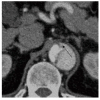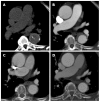Multi-detector computed tomography in the diagnosis and management of acute aortic syndromes
- PMID: 24976936
- PMCID: PMC4072820
- DOI: 10.4329/wjr.v6.i6.355
Multi-detector computed tomography in the diagnosis and management of acute aortic syndromes
Abstract
Acute aortic syndrome (AAS) is a spectrum of conditions, which may ultimately progress to potentially life-threatening aortic rupture. This syndrome encompasses aortic dissection (AD), intramural haematoma, penetrating atherosclerotic ulcer and unstable thoracic aortic aneurysms. Multi-detector CT (MDCT) is crucial for the diagnosis of AAS, especially in the emergency setting due to its speed, accuracy and ready availability. This review attends to the value of appropriate imaging protocols in obtaining good quality images that can permit a confident diagnosis of AAS. AD is the most commonly encountered AAS and also the one with maximum potential to cause catastrophic outcome if not diagnosed and managed promptly. Hence, this review briefly addresses certain relevant clinical perspectives on this condition. Differentiating the false from the true lumen in AD is often essential; a spectrum of CT findings, e.g., "beak sign", aortic "cobwebs" that allows such differentiation have been described with explicit illustrations. The value of non enhanced CT scans, especially useful in the diagnosis of an intramural hematoma has also been illustrated. Overlap in the clinical and imaging features of the various conditions presenting as AAS is not unusual. However, on most instances MDCT enables the right diagnosis. On select occasions MRI or trans-esophageal echocardiography may be required as a problem solving tool.
Keywords: Acute aortic syndrome; Aortic aneurysm; Aortic dissection; Computed tomography scan; Intramural haematoma; Penetrating aortic ulcer.
Figures











Similar articles
-
Computed Tomography Imaging Findings of Acute Aortic Pathologies.Cureus. 2019 Aug 30;11(8):e5534. doi: 10.7759/cureus.5534. Cureus. 2019. PMID: 31687308 Free PMC article. Review.
-
Acute aortic syndrome: CT findings.Clin Radiol. 2013 Jul;68(7):741-8. doi: 10.1016/j.crad.2013.03.001. Epub 2013 Apr 11. Clin Radiol. 2013. PMID: 23582433 Review.
-
MDCT evaluation of acute aortic syndrome (AAS).Br J Radiol. 2016;89(1061):20150825. doi: 10.1259/bjr.20150825. Epub 2016 Apr 1. Br J Radiol. 2016. PMID: 27033344 Free PMC article. Review.
-
Multi-detector row computed tomography: imaging in acute aortic syndrome.Clin Radiol. 2005 Dec;60(12):1256-67. doi: 10.1016/j.crad.2005.06.011. Clin Radiol. 2005. PMID: 16291307 Review.
-
Acute aortic syndrome-pitfalls on gated and non-gated CT scan.Emerg Radiol. 2016 Aug;23(4):397-403. doi: 10.1007/s10140-016-1409-y. Epub 2016 May 24. Emerg Radiol. 2016. PMID: 27220654 Review.
Cited by
-
Systematic analysis of the radiologic findings of aortic dissections on unenhanced postmortem computed tomography.Forensic Sci Med Pathol. 2015 Jun;11(2):162-7. doi: 10.1007/s12024-015-9654-z. Epub 2015 Feb 28. Forensic Sci Med Pathol. 2015. PMID: 25724838
-
Significance of an additional unenhanced scan in computed tomography angiography of patients with suspected acute aortic syndrome.World J Radiol. 2018 Nov 28;10(11):150-161. doi: 10.4329/wjr.v10.i11.150. World J Radiol. 2018. PMID: 30568749 Free PMC article.
-
Emergent Endovascular Stent Grafts for Ruptured Aortic Aneurysms.Semin Intervent Radiol. 2015 Sep;32(3):249-58. doi: 10.1055/s-0035-1556879. Semin Intervent Radiol. 2015. PMID: 26327743 Free PMC article. Review.
-
[Diagnostics and treatment of traumatic aortic injuries].Unfallchirurg. 2021 Aug;124(8):601-609. doi: 10.1007/s00113-021-01044-0. Epub 2021 Jul 12. Unfallchirurg. 2021. PMID: 34254152 Free PMC article. Review. German.
-
Association Between IV Contrast Media Exposure and Acute Kidney Injury in Patients Requiring Emergency Admission: A Nationwide Observational Study in Japan.Crit Care Explor. 2024 Aug 26;6(9):e1142. doi: 10.1097/CCE.0000000000001142. eCollection 2024 Sep 1. Crit Care Explor. 2024. PMID: 39186608 Free PMC article.
References
-
- Chiu KW, Lakshminarayan R, Ettles DF. Acute aortic syndrome: CT findings. Clin Radiol. 2013;68:741–748. - PubMed
-
- Nienaber CA, Powell JT. Management of acute aortic syndromes. Eur Heart J. 2012;33:26–35b. - PubMed
-
- Jánosi RA, Erbel R, Konorza TF. Recent advances in the diagnosis of acute aortic syndromes. Expert Opin Med Diagn. 2012;6:529–540. - PubMed
-
- Akin I, Kische S, Ince H, Nienaber C. Penetrating aortic ulcer, intramural hematoma, acute aortic syndrome: when to do what. J Cardiovasc Surg (Torino) 2012;53:83–90. - PubMed
Publication types
LinkOut - more resources
Full Text Sources
Other Literature Sources

